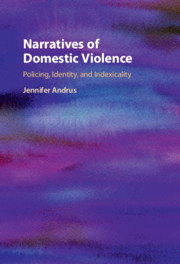Book contents
- Narratives of Domestic Violence
- Narratives of Domestic Violence
- Copyright page
- Dedication
- Contents
- Figures
- Tables
- Extracts
- Notes on the Text
- Acknowledgments
- Introduction
- 1 Domestic Violence, Violence against Women, and Patriarchy
- 2 Toward the Recreation of a Field of Indexicality
- 3 Storying the Victim/Survivor
- 4 Storying Policing
- 5 Conclusions
- References
- Index
- References
References
Published online by Cambridge University Press: 16 November 2020
- Narratives of Domestic Violence
- Narratives of Domestic Violence
- Copyright page
- Dedication
- Contents
- Figures
- Tables
- Extracts
- Notes on the Text
- Acknowledgments
- Introduction
- 1 Domestic Violence, Violence against Women, and Patriarchy
- 2 Toward the Recreation of a Field of Indexicality
- 3 Storying the Victim/Survivor
- 4 Storying Policing
- 5 Conclusions
- References
- Index
- References
- Type
- Chapter
- Information
- Narratives of Domestic ViolencePolicing, Identity, and Indexicality, pp. 213 - 219Publisher: Cambridge University PressPrint publication year: 2020



